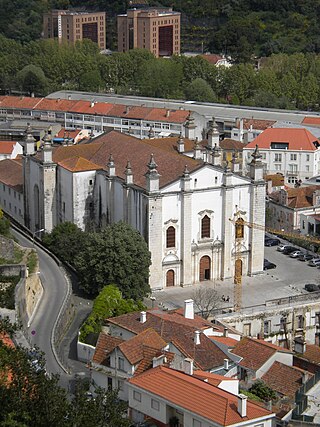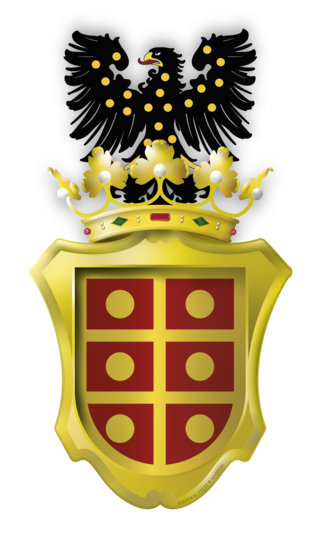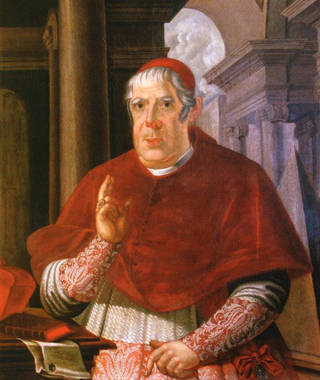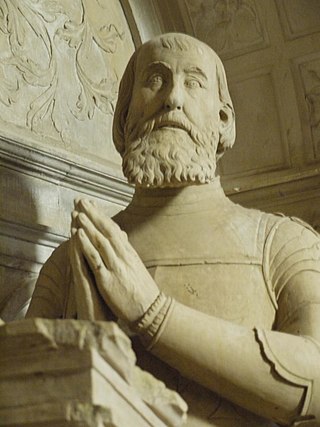
The Most Serene House of Braganza, also known as the Brigantine dynasty, is a dynasty of emperors, kings, princes, and dukes of Portuguese origin which reigned in Europe and the Americas.

The Metropolitan Patriarchate of Lisbon is a Latin Church ecclesiastical territory or patriarchal archdiocese of the Catholic Church in Lisbon, the capital of Portugal.
São João de Areias is a Portuguese civil parish in the municipality (concelho) of Santa Comba Dão, in the former-district of Viseu. The population in 2011 was 1,939, in an area of 21.51 km2.

The Archdiocese of Braga is a Latin Church ecclesiastical territory or archdiocese of the Catholic Church in Portugal. It is known for its use of the Rite of Braga, a use of the liturgy distinct from the Roman Rite and other Latin liturgical rites.

Martim Moniz was a Portuguese knight of noble birth, and famous figure in the Siege of Lisbon in 1147.

The Diocese of Coimbra is a Latin Church diocese of the Catholic Church in Coimbra, Portugal. It is a suffragan of the Archdiocese of Braga.

The Roman Catholic Diocese of Funchal is a Latin Church ecclesiastical territory or patriarchal archdiocese of the Catholic Church in Portugal. It was originally created on 12 June 1514 by the papal bull Pro excellenti præeminentia from Pope Leo X, following the elevation of Funchal from a village to the status of city, by King Manuel I of Portugal. The diocese was a suffragan of the Archdiocese of Lisbon.

The Diocese of Leiria–Fátima is a Latin Church diocese of the Catholic church in Portugal. It is suffragan diocese in the ecclesiastical province of the Metropolitan Patriarchate of Lisbon.

The Diocese of Guarda is a Latin Church diocese of the Catholic church in central eastern Portugal, a suffragan in the ecclesiastical province of the Latin Patriarchate of Lisbon in southern Portugal.

Marquess of Lavradio is a Portuguese title of nobility created by Letters Patent of King José I of Portugal on 18 October 1753 for D. António de Almeida Soares de Portugal, 1st Count of Lavradio and 4th Count of Avintes.
Miguel António de Sousa Horta Almeida e Vasconcelos, 2nd Baron of Santa Comba Dão was a Portuguese nobleman.

Dom António de Ataíde, 1st count of Castanheira, was a childhood friend and favorite of King John III of Portugal. As an advisor to the King, he played a key role in Portugal's policies towards its colony of Brazil. He also served as a diplomat in missions to several European countries and was a Minister and member of the King's council.

D. John Manuel of Athanagilds, 9th Count of Arganil was a Portuguese prelate, Archbishop of Lisbon and Viceroy of Portugal.

Frei Francisco de São Luís, O.S.B., religious name of Francisco Manuel Justiniano Saraiva and today more commonly known as Cardinal Saraiva, was a Portuguese Cardinal of the Catholic Church, who was the eighth Patriarch of Lisbon from 1840 to 1845.

Lopo de Almeida (1416–1486) was the first Count of Abrantes bestowed with the title on June 13, 1476 by King D. Afonso V of Portugal.

Duarte Galvão was a Portuguese courtier, diplomat and chronicler.

Duarte de Lemos, 3rd Lord of Trofa, was a 16th century Portuguese nobleman, soldier and donatary. In Brazil, he was Lord of the island of Santo Antônio, the present-day island of Vitória, where the capital of the state of Espírito Santo was founded.

João Galvão, originally João Rodrigues da Costa or João Rodrigues Galvão, was a Portuguese Catholic clergyman and the first to hold the title of Count of Arganil.
















